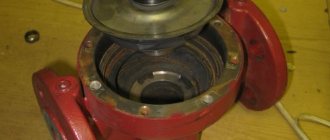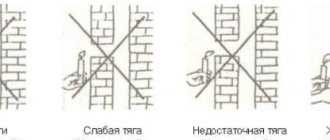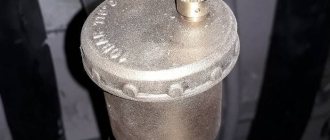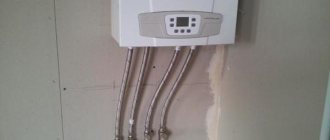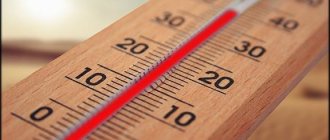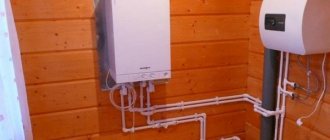The main malfunctions of the water heating system are a decrease in the temperature in the heated rooms compared to the calculated ones and a violation of the tightness of the heating system elements. A decrease in room temperature can be caused by the following reasons: disruption of coolant circulation, malfunction of the control unit, unauthorized connection of additional heating devices (radiators, convectors, water heated floors, etc.).
When the temperature in the premises decreases, first of all, you need to make sure that no preventive maintenance or repairs are being carried out on the heating system. Once you are convinced of this, you can begin to search for and eliminate the causes of the decrease in temperature. Use a thermometer to check the temperature of the coolant supplied to the heating system. If the temperature in the heating system is lower than required, the fault must be looked for in the control unit. If the temperature of the heating system coolant corresponds to the norm, then the malfunction of the heating system consists of a violation of the coolant circulation or the heating system is incorrectly adjusted.
Disturbance in the circulation of the coolant in the heating system can occur: due to errors in the installation of pipelines, pipeline fittings are faulty or absent, a decrease in pressure due to water leaks, complete or partial blockage of the riser, due to improper piping of heating devices, airing of the system heating - air entering the heating system.
Overhaul of heating systems in a private home
Major repairs of home heating systems, as a rule, involve their partial or complete reconstruction.
With proper preparation, such repairs can be done by yourself without damaging the interior of the home. Currently, the market offers modern, functional and high-quality press fittings that allow you to repair home heating systems without soldering and welding, which is very convenient in cases where major repairs of heating systems do not involve repairing the house itself. This is the most cost-effective solution for doing home heating system repairs yourself.
Major repairs of home heating systems may include the following work:
- boiler replacement;
- replacement of radiators;
- replacement of pipelines;
- replacement of individual sections of home heating systems;
- replacement of the entire heating system;
- other repair work related to the replacement of certain parts and assemblies.
Heating diagram for a two-story house.
Major repairs of home heating systems can be spontaneous or planned. Of course, the second option is more preferable, because involves the opportunity to thoroughly prepare for its implementation with your own hands, to purchase the necessary equipment and materials. All other things being equal, this is the most profitable solution. However, practice shows that another option is much more common. Often, a major overhaul of home heating systems is caused by an urgent need, when it is no longer possible to avoid it. Sometimes this entails eliminating many serious problems, because even the most experienced technician may not immediately understand a system unfamiliar to him, not to mention doing the repair himself.
The likelihood of such cases can be minimized. Timely measures taken make it possible to independently choose the time for major repairs and slowly do it yourself. It cannot be completely avoided, because any equipment has a limited service life and sooner or later it will be necessary, for example, to replace the boiler or lay new pipelines.
Hydraulic tests
Pressure testing is carried out within 2 - 3 days at elevated pressure.
Hydraulic tests of the heating system (pressure testing) are planned and control measures designed to check the reliability of heat exchange equipment. This action is carried out in order to detect components, equipment and communication sections that are potentially dangerous in terms of leaks. Hydraulic tests should be performed before the start of the heating season, after completion of planned or major repairs of the system.
During the inspection process, water is pumped into the pipes and air is released. Then, using a pump with a pressure gauge, a pressure of 2-6 atm is created in the circuit, which is higher than the nominal one. Signs of a malfunction are leaks and drops of water at the joints. After eliminating the defects, the test is repeated. A prerequisite is the use of hot water, the temperature of which is equal to or higher than the calculated one. The thermal test shows the true readiness of the circuit for operation.
Repair of home heating system batteries
Heating is a determining factor in creating comfortable and safe living in a particular house or apartment. Heating systems consisting of a variety of units and installations help provide heat to apartments and houses. The quality performance of its functions by the heating system as a whole depends on the uninterrupted and reliable operation of each component. In view of this, repairing heating radiators, laying new pipelines and other measures are very important and urgent. After all, if the battery fails, the system is unlikely to be able to provide your home with the necessary heat.
A visual diagram of the heating system in a private house.
An interesting fact is that repair of heating radiators and installation of new pipelines are often required by those owners who simply decided to replace old batteries with more reliable and modern ones. The reliability of the system will largely depend not only on how well the batteries are installed and the pipelines are installed, but also on the choice of units. There are various types of such products available in the modern market.
Before choosing certain batteries, consult with professionals, as... Not all radiators may suit you. The main selection criteria are the technological characteristics of the batteries: their suitability for a specific pipe diameter, tolerance of a certain pressure and compatibility with the type of heating system in your home. When planning to repair heating radiators with your own hands, pay attention to the fact that they can be made of various materials. For example, aluminum models are distinguished by the highest level of heat transfer, and bimetallic radiators are made using 2 materials (steel and aluminum).
The combination of 2 materials makes the radiators as durable as possible, while heat transfer also remains at a high level. Do-it-yourself battery repair using such devices is, of course, a very practical undertaking.
What to do if the bottom of the battery is colder than the top?
If the battery is hot on top and cold on the bottom, it is not functioning properly. In this case, diagnostics are required not only by the battery itself, but also by the entire heating system. The cause of the problem may lie in recent work on the heating system and replacement of the radiator. As a rule, the “hot top – cold bottom” problem appears due to an air lock (99% of cases) or a clogged radiator valve (a consequence of improper start-up of the system).
This problem is solved in two ways. You can remove the air lock using a Mayevsky tap or a bleeder. First of all, turn off the coolant supply to the radiator and leave the return line open. Open the drain, wait until the air comes out, close the drain and open the coolant supply. As a rule, this is enough.
If this method does not work, and we are talking about an apartment building, it is better to call a specialist. For private houses there is another option. First you need to turn off the heating supply, open the drain at the highest point of the system and use back pressure to squeeze out all the air.
Each heating system may have its own characteristics, and therefore there is a high probability of atypical problems arising. These include incorrectly selected pipe diameters, incorrect coolant distribution, poor throughput, lack of pressure, problems with the circulation pump or expansion tank. In any case, only a specialist can fully understand all the nuances, so in case of difficulties in solving the problem, it is better to seek help.
Repair of boilers for home heating systems
Scheme of water heating of a private house.
Repairing heating boilers with your own hands requires special knowledge, experience and skills. In addition, it will not be possible to do without specialized tools and equipment. The need for such events can be caused by various reasons. So, in some cases we are talking about minor breakdowns or simple preventive maintenance, in others, the repair of home heating boilers is associated with eliminating the consequences of various accidents.
A lot in this case depends on the homeowner. If he does not neglect preventive measures and carries out regular inspection and maintenance of the equipment, both with his own hands and with the involvement of qualified specialists, then serious repairs are unlikely to be required. It's another matter if the system works without proper attention and care. Over time, such disregard of its interests on the part of the owner will result in the appearance of many problems, so it is imperative to show due care and attention to the heating system of your home. In this case, you will almost certainly be able to limit yourself to minor preventive repairs that you can do yourself.
Heating system maintenance includes:
Scheme of operation of a steam heating system.
- correct boiler settings;
- preparing equipment for the heating season;
- checking sensors;
- checking the operation of equipment automation;
- identifying the causes of boiler failure.
Of course, if, for one reason or another, you need to carry out more serious repairs of heating boilers, you will have to involve specialists with qualifications and experience, because by doing the repairs yourself without the proper knowledge, you can make everything even worse.
We recommend: How to connect a well pump - installation and electrical diagram, installation in a well
It is very important to understand that there is a huge variety of different equipment on the modern market. Consequently, when it comes to repairing heating boilers with the replacement of parts and components, additional difficulties may arise in finding them. That is why experts advise performing all preventive work in a timely manner. Then it will be possible to order the necessary components in advance, without waiting until they completely break down.
Why is the bottom of the battery cold and the top hot?
Often on construction forums people complain about heating systems - the bottom of the radiator is cold and the top is hot. It is worth noting that any radiator on top is warmer than on the bottom, but if the gap between these temperatures is too large, then most likely there is something wrong with the system. Moreover, this means that the battery produces less thermal energy than it should. After all, everyone knows that the efficiency of heating devices directly depends on the uniform heating of their surfaces.
Today we will try to figure out why this phenomenon occurs and what needs to be done about it.
How to change the battery in an apartment
Previously, we talked about how to quickly and easily replace a heating battery in an apartment with your own hands, in addition to this article, we advise you to read this information
Do-it-yourself solutions to common heating problems
Typical heating problems in a private home can be solved with your own hands. Prepare the necessary tools for this:
- Drill.
- Gas and adjustable wrenches.
- Hammer.
- Screwdriver.
Diagram of a heating boiler for a private house.
Depending on each specific situation, you may need other tools, but you definitely won’t be able to cope without the above.
If one or several batteries heat poorly or do not heat at all, then first of all you need to check whether there is air in them using air vents. If water flows from the drains, but the battery still does not heat, make sure that both taps of this radiator are open. The next step is to check the radiator for clogging. To do this, other heating radiators that heat normally and are located on the same branch as the faulty one must be shut off so that all the water flows through this battery. If it starts to warm up, it means it is not clogged. In this case, it is necessary to perform hydraulic leveling of the branch, i.e. cover the remaining batteries on the branch so that more goes to the non-working one.
Be prepared for the fact that leveling will take quite a long time, because the heating system can respond very slowly to changes in its settings.
If the taps in front of the battery are completely open and it is cold, then it is clogged (which is extremely unlikely). Basically, the last batteries on the branch may not heat up. However, this can always be corrected by hydraulic leveling. If suddenly someone tells you that “it just doesn’t pump there” or “the pump power is not enough,” do not rush to believe and touch the pipes or pump. In order to “not pump too much”, it is necessary to make many mistakes when installing the heating system, the probability of which is negligible.
Another fairly common problem is a drop in pressure in the heating system. Once again, we need to remind you that after starting the heating system you need to let it work for several days or even weeks. Air is dissolved in the heating system, which comes out during manual deaeration and automatic air vents, but it does this gradually. This leads to a decrease in pressure in the system. At first, frequent replenishment of the heating system is quite commonplace. If the heating has been running for more than a month and the pressure is still dropping, you can check the next version.
If the volume of the expansion tank is incorrectly calculated, pressure surges in the heating system may occur, as a result of which the safety valve may operate (discharge water). As a result, when cooling there will be a drop in pressure. If everything is fine with this, then the problem is a leak in the system and you will have to find a leak.
Another fairly common problem is pressure surges in the heating system. The expansion tank is responsible for compensating for changes in the volume of the heating system. Consequently, if the pressure changes over a wide range when the temperature changes, then the reason is precisely in the expansion tank: it is either broken or its required volume was calculated incorrectly. This usually leads to the safety valve tripping or even stopping the boiler due to insufficient pressure in the system. To resolve this problem, it is better to contact specialists.
Types of air vents
Valves for removing air locks are automatic and manual. The second type of air vents includes Mayevsky taps. They are used not only to remove air, but also to start it up in order to drain the coolant from the system.
Mayevsky crane
This device is made of brass and has a simple but reliable design. The main parts of the Mayevsky crane are the body and the screw. All valve parts are located as closely as possible to each other, so that the coolant cannot escape outside. Open the tap using a special key, screwdriver or hand.
Before removing air from the heating system, it is necessary to prepare a container for the coolant and tools. Step-by-step instructions for removing air pockets using a Mayevsky crane:
- If the heating system operates using a circulation pump, it should be turned off while the air is being vented.
- Using a wrench, screwdriver or hand, turn the tap 1 turn counterclockwise. You will immediately hear the hiss of air escaping from the radiator.
- As soon as the coolant begins to flow out, it means that the air lock has been removed, the Mayevsky valve is closed back.
Automatic air vent
This device independently removes air from the heating system. Installs either vertically or horizontally. Consists of a brass body, float, release valve and articulated arm. To prevent coolant from leaking through it, the air vent is equipped with a protective cap.
The operating principle is as follows: if there is no air in the chamber, then the outlet valve is closed. As it moves in, the float lowers. Once the chamber is completely filled, the exhaust valve opens and the air is discharged outside. The float then closes the outlet valve again.
Air separator
This device consists of a metal body, an air vent, a drain valve and a tube with a mesh. Unlike conventional air vents, the separator itself removes air from the water. As the coolant passes through the mesh, it swirls, causing air bubbles to form. As a result, they rise to the top, and the gases are removed through the air vent. In addition to air, the separator separates sand, rust and other impurities. Remove sludge through a drain valve located outside at the bottom of the housing.
It's clogged and clogged.
Every heating system must have a coarse filter. A very small device with a fine mesh and a sump (installed downwards! or at least to the side) saves equipment, pumps, and the boiler from coolant contamination that will be present in any system. Wood shavings, broken threads, rust, water sediment…. everything is retained by the mesh in the filter.
The sedimentation tank must be periodically untwisted and the mesh cleaned.
If the circulation in the heating system of a private house is disrupted, then the first thing you need to do is check the filter, which should be installed on the return line in front of the boiler.
Coarse filter
As mentioned above, one of the reasons that there is no coolant circulation may be the accumulation of debris in the pipeline. To completely avoid this, again, we don’t save on pennies, but install a coarse filter in front of each device:
Using a filter, catching dirt is easier than correcting the consequences of clogged pipelines or boiler heat exchangers.
Conclusion! We place coarse filters in front of each heating system device (pump, boiler, etc.) and in front of each plumbing fixture. We do NOT save pennies to “buy” problems. There are arrows stamped on the filter housing indicating the direction of movement of the coolant or water in the water supply...
The filter needs to be cleaned regularly. And this is very simple to do: close the valves before and after the filter - unscrew the plug (1) on the filter - remove and rinse the mesh under the tap - put it in place and tighten the plug. All. Not like changing pipes
